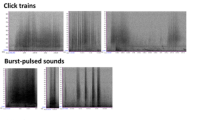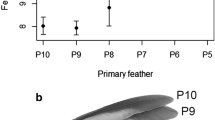Abstract
To respond appropriately to communication signals, animals must have the ability to decipher signal meaning. At a basic level, interpreting the difference between territorial and courtship signals can be vital for the survival and reproduction of social animals. Male and female fiddler crabs communicate with claw-waving displays, but the function of these waves remains uncertain. Species differ in the context in which they wave: Some wave during courtship, some during territorial defence and some during both. In this paper, we provide evidence that males of an Australian species of fiddler crab, Uca perplexa, use two different types of claw waving display, lateral and vertical. Lateral waves are employed solely in a courtship context, whilst vertical waves are employed during courtship as well as territorial interactions. Using video recordings, we show that lateral waves were produced spontaneously (broadcast), and their frequency increased only in the presence of female wanderers. Vertical waves were not broadcast but were elicited by male wanderers during agonistic interactions and female wanderers during close range courtship. Male resident U. perplexa were able to discriminate the sex of wandering crabs on the mudflat at distances of 32 cm. During all resident–wanderer interactions, residents attempted to maintain a position directly between the wanderer and the home burrow and orient themselves to face females and to present the major claw towards males. To our knowledge, this is the first demonstration of the multiple use of waving displays in a fiddler crab species.





Similar content being viewed by others
References
Aicher B, Tautz J (1990) Vibrational communication in the fiddler crab, Uca pugilator: 1. Signal transmission through the substratum. J Comp Physiol A 166:345–353
Aizawa N (1998) Synchronous waving in an ocypodid crab, Ilyoplax pusilla: analyses of response patterns to video and real crabs. Mar Biol 131:523–532
Altevogt R (1957) Untersuchungen zur Biologie, Ökologie und Physiologie indischer Winkerkrabben. Z Morphol Ökol Tiere 46:1–110
Backwell PRY, Passmore NI (1996) Time constraints and multiple choice criteria in the sampling behaviour and mate choice of the fiddler crab, Uca annulipes. Behav Ecol Sociobiol 38:407–416
Backwell PRY, Jennions MD, Christy JH, Passmore NI (1999) Female choice in the synchronously waving fiddler crab Uca annulipes. Ethology 105:415–421
Backwell PRY, Christy JH, Telford SR, Jennions MD, Passmore NI (2000) Dishonest signalling in a fiddler crab. Proc R Soc Lond B 267B:719–724
Batschelet E (1981) Circular statistics in biology. Academic, London
Bouguet JY (2005) Camera Calibration Toolbox for Matlab. Accessed 12/5/2006. MRL—Intel. www.vision.caltech.edu/bouguetj/calib_doc
Bradbury JW, Vehrencamp SL (1998) Principles of animal communication. Sinauer, Sunderland, MA
Christy JH (1978) Adaptive significance of reproductive cycles in the fiddler crab Uca pugilator: a hypothesis. Science 199:453–455
Christy JH (1983) Female choice in the resource-defense mating system of the sand fiddler crab, Uca pugilator. Behav Ecol Sociobiol 12:169–180
Christy JH, Salmon M (1984) Ecology and evolution of mating systems of fiddler crabs (genus Uca). Biol Rev Camb Philos Soc 59:483–509
Christy JH, Backwell PRY, Goshima S (2001) The design and production of a sexual signal: hoods and hood building by male fiddler crabs Uca musica. Behav 138:1065–1083
CRAN (2006) R 2.3.1. A language for statistical computing. Accessed 1st June 2006. R Foundation for Statistical Computing, Vienna www.cran.r-project.org
Crane J (1957) Basic patterns of display in fiddler crabs (Ocypodidae, genus Uca). Zoologica (NY) 42:69–82
Crane J (1975) Fiddler crabs of the world. Ocypodidae: Genus Uca. Princeton University Press, New Jersey
Dalgaard P (2002) Introductory statistics with R. Springer, New York
deRivera CE (2005) Long searches for male-defended breeding burrows allow female fiddler crabs, Uca crenulata, to release larvae on time. Anim Behav 70:289–297
deRivera CE, Vehrencamp SL (2001) Male versus female mate searching in fiddler crabs: a comparative analysis. Behav Ecol 12:182–191
deRivera CE, Backwell PRY, Christy JH, Vehrencamp SL (2003) Density affects female and male mate searching in the fiddler crab, Uca beebei. Behav Ecol Sociobiol 53:72–83
Detto T, Backwell PRY, Hemmi JM, Zeil J (2006) Visually mediated species and neighbour recognition in fiddler crabs (Uca mjoebergi and Uca capricomis). Proc R Soc Lond B 273:1661–1666
Genstat (2006) Genstat for Windows Release 9.1. VSN International, Oxford
Gordon HRS (1958) Synchronous claw-waving of fiddler crabs. Anim Behav 6:238–241
Hanson FE, Case JF, Buck E, Buck J (1971) Synchrony and Flash Entrainment in a New Guinea Firefly. Science 174:161–164
Hemmi JM, Zeil J (2003a) Burrow surveillance in fiddler crabs. I. Description of behaviour. J Exp Biol 206:3935–3950
Hemmi JM, Zeil J (2003b) Burrow surveillance in fiddler crabs. II. The sensory cues. J Exp Biol 206:3951–3961
Hemmi JM, Zeil J (2003c) Robust judgement of inter-object distance by an arthropod. Nature 421:160–163
Hyatt GW (1977) Quantitative analysis of size-dependent variation in the fiddler crab wave display (Uca pugilator, Brachyura, Ocypodidae). Mar Behav Physiol 5:19–36
Kim TW, Choe JC (2003) The effect of food availability on the semilunar courtship rhythm in the fiddler crab Uca lactea (de Haan) (Brachyura: Ocypodidae). Behav Ecol Sociobiol 54:210–217
Land M, Layne J (1995a) The visual control of behaviour in fiddler crabs. 1. Resolution, thresholds and the role of the horizon. J Comp Physiol A 177:81–90
Land M, Layne J (1995b) The visual control of behaviour in fiddler crabs. 2. Tracking control-systems in courtship and defense. J Comp Physiol A 177:91–103
Matsumasa M, Murai M (2005) Changes in blood glucose and lactate levels of male fiddler crabs: effects of aggression and claw waving. Anim Behav 69:569–577
Maynard Smith J, Harper D (2003) Animal signals. Oxford University Press, Oxford
McCulloch CE, Searle SR (2001) Generalized, linear, and mixed models. Wiley, New York
Moriito M, Wada K (2000) The presence of neighbors affects waving display frequency by Scopimera globosa (Decapoda, Ocypodidae). J Ethol 18:43–45
Müller W (1989) Untersuchungen zur akustisch-vibratorischen Kommunikation und Ökologie tropischer und subtropischer Winkerkrabben. Zool Jahrb Abt Syst Ökol Geogr Tiere 116:47–114
Murai M, Backwell PRY (2005) More signalling for earlier mating: conspicuous male claw waving in the fiddler crab, Uca perplexa. Anim Behav 70:1093–1097
Murai M, Backwell PRY (2006) A conspicuous courtship signal in the fiddler crab Uca perplexa: female choice based on display structure. Behav Ecol Sociobiol 60:736–741
Murai M, Goshima S, Henmi Y (1987) Analysis of the mating system of the fiddler crab, Uca lactea. Anim Behav 35:1334–1342
Nakasone Y, Murai M (1998) Mating behaviour of Uca lactea perplexa (Decapoda, Ocypodidae). J Crustac Biol 18:70–77
Peters HM (1955) Die Winkgebärden von Uca and Minuca (Brachyura) in vergleichend-ethologischer, ökologischer und morphologisch anatomischer Betrachtung. Z Morphol Ökol Tiere 43:425–500
Pope DS (2000) Testing function of fiddler crab claw waving by manipulating social context. Behav Ecol Sociobiol 47:432–437
Pope DS (2005) Waving in a crowd: fiddler crabs signal in networks. In: McGregor PK (ed) Animal communication networks. Cambridge University Press, Cambridge, pp 252–276
Rosenberg MS (2001) The systematics and taxonomy of fiddler crabs: A phylogeny of the genus Uca. J Crustac Biol 21:839–869
Salmon M (1967) Coastal distribution, display and sound production by Florida fiddler crabs (genus Uca). Anim Behav 15:449–459
Salmon M (1984) The courtship, aggression and mating system of a “primitive” fiddler crab (Uca vocans: Ocypodidae). Trans Zool Soc Lond 37:1–50
Salmon M (1987) On the reproductive behavior of the fiddler crab Uca thayeri, with comparisons to Uca pugilator and Uca vocans: evidence for behavioral convergence. J Crustac Biol 7:25–44
Salmon M, Atsaides SP (1968) Visual and acoustical signalling during courtship by fiddler crabs (genus Uca). Am Zool 8:623–639
Salmon M, Horch KW (1972) Acoustic signalling and detection by semiterrestrial crabs of the family Ocypodidae. In: Winn, HE, Olla, BL (eds) Behavior of marine animals, vol 1: Invertebrates. Plenum, New York, pp 60–96
Salmon M, Hyatt GW, McCarthy K, Costlow JD (1978) Display specificity and reproductive isolation in the fiddler crabs, Uca panacea and U. pugilator. Z Tierpsychol 48:251–276
Schall R (1991) Estimation in generalized linear models with random effects. Biometrika 78:719–727
Schöne H (1968) Agonistic and sexual display in aquatic and semi-terrestrial brachyuran crabs. Am Zool 8:641–654
Severinghaus LL, Lin HC (1990) The reproductive behaviour and mate choice of the fiddler crab (Uca lactea lactea) in mid-Taiwan. Behav 113:292–307
Verwey J (1930) Einiges über die Biologie Ost-Indischer Mangrovenkrabben. Treubia 12:167–261
von Hagen H-O (1984) Visual and acoustic display in Uca mordax and U. burgersi, sibling species of neotropical fiddler crabs. II. Vibration signals. Behaviour 91:204–228
von Hagen H-O (1993) Waving display in females of Uca polita and of other Australian fiddler crabs. Ethology 93:3–20
von Hagen H-O (2000) Vibration signals in Australian fiddler crabs—a first inventory. The Beagle, Records of the Northern Territory Museum of Arts and Sciences 16:97–106
Wiley RH (1978) Lek mating system of sage grouse. Sci Am 238:114–125
Willis MA, Birch MC (1982) Male lek formation and female calling in a population of the Arctiid moth Estigmene acrea. Science 218:168–170
Zeil J (1998) Homing in fiddler crabs (Uca lactea annulipes and Uca vomeris: Ocypodidae). J Comp Physiol 183A:367–377
Zeil J, Al-Mutairi MM (1996) The variation of resolution and of ommatidial dimensions in the compound eyes of the fiddler crab Uca lactea annulipes (Ocypodidae, Brachyura, Decapoda). J Exp Biol 199:1569–1577
Zeil J, Layne JE (2002) Path integration in fiddler crabs and its relation to habitat and social life. In: Wiese, K (eds) Crustacean experimental systems in neurobiology. Springer, Berlin, pp 227–246
Zeil J, Hemmi JM (2006) The visual ecology of fiddler crabs. J Comp Physiol A 192:1–25
Zucker N (1978) Monthly reproductive cycles in three sympatric hood-building tropical fiddler crabs (genus Uca). Biol Bull 155:410–424
Acknowledgements
We wish to thank Waldtraud Pix and Jochen Smolka for their support in the field, the Australian Institute for Marine Science for hosting fieldwork, the Research School of Biological Sciences workshop team for the custom-made equipment, Dr. Emlyn Williams of the Statistical Consulting Unit at the Australian National University for advice and the referees for their comments on an earlier version of the manuscript, which helped to improve it greatly. Funding was provided by a Research School of Biological Sciences postgraduate award to M J How, by the Australian National University Deputy Vice Chancellor’s fund for fieldwork assistance and by the ARC Centre of Excellence in Vision Science at the Australian National University. The experiments comply with the current laws of the country in which they were performed.
Author information
Authors and Affiliations
Corresponding author
Additional information
Communicated by: P. Backwell
Rights and permissions
About this article
Cite this article
How, M.J., Zeil, J. & Hemmi, J.M. Differences in context and function of two distinct waving displays in the fiddler crab, Uca perplexa (Decapoda: Ocypodidae). Behav Ecol Sociobiol 62, 137–148 (2007). https://doi.org/10.1007/s00265-007-0448-5
Received:
Revised:
Accepted:
Published:
Issue Date:
DOI: https://doi.org/10.1007/s00265-007-0448-5




